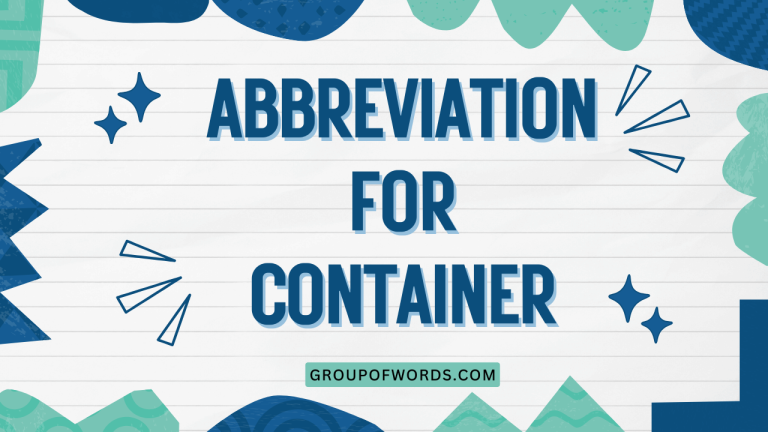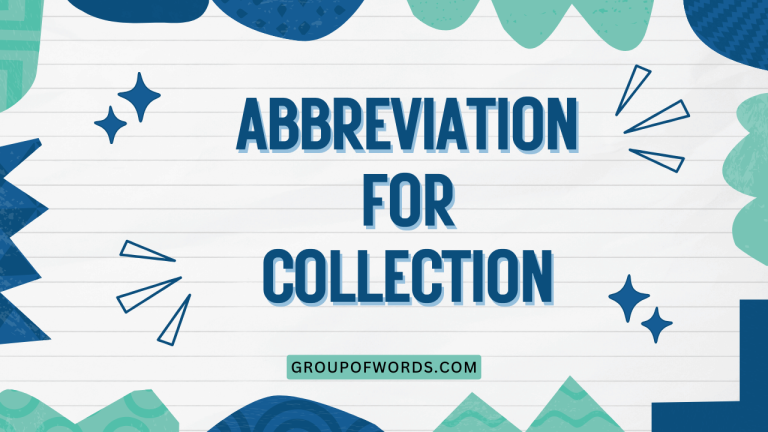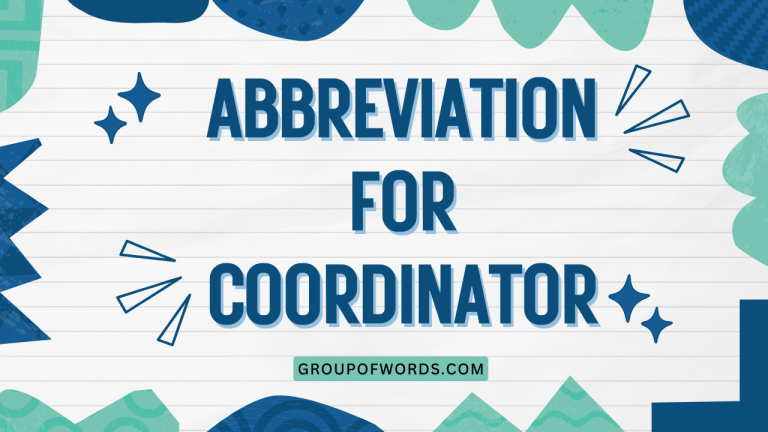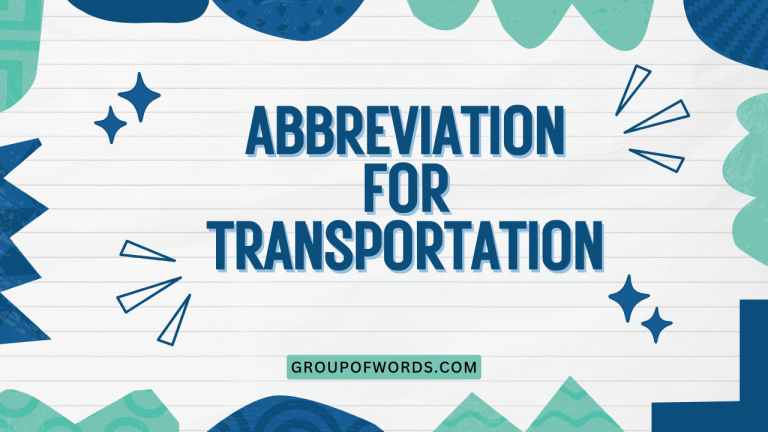Abbreviations for Replacement: A Comprehensive Guide
Understanding abbreviations for replacement is crucial for effective communication in various contexts, from formal writing to casual conversation. These abbreviations, which stand in for longer phrases or words, enhance efficiency and clarity when used correctly.
This article will provide a comprehensive exploration of abbreviations for replacement, covering their definition, types, usage rules, common mistakes, and advanced applications. Whether you’re a student, professional, or language enthusiast, mastering these abbreviations will significantly improve your English proficiency.
Table of Contents
- Introduction
- Definition and Explanation
- Structural Breakdown
- Types and Categories
- Examples
- Usage Rules
- Common Mistakes
- Practice Exercises
- Advanced Topics
- FAQ
- Conclusion
Definition and Explanation
An abbreviation for replacement is a shortened form of a word or phrase used in place of the full version. These abbreviations serve to condense language, making it more efficient and easier to read or speak.
Abbreviations can be categorized based on how they are formed and used, including acronyms, initialisms, contractions, shortenings, and symbols. The primary function of these abbreviations is to save time and space, especially in writing and technical contexts.
Understanding the different types and their appropriate usage is crucial for clear and effective communication.
Structural Breakdown
The structure of abbreviations varies based on their type. Acronyms are formed from the first letters of a series of words and are pronounced as a single word (e.g., NASA).
Initialisms are also formed from the first letters of a series of words, but each letter is pronounced individually (e.g., FBI). Contractions combine two words into one by omitting certain letters, which are usually replaced by an apostrophe (e.g., cannot becomes can’t).
Shortenings involve truncating a word, often at the beginning or end (e.g., advertisement becomes ad). Symbols are graphical representations that stand in for words or concepts (e.g., $ for dollar).
The structural breakdown of each type dictates how it’s formed and used within sentences.
Types and Categories
Acronyms
Acronyms are abbreviations formed from the initial letters of a series of words and pronounced as a single word. They are widely used in various fields, including science, technology, and government, to simplify complex terms and organizations.
For example, NASA (National Aeronautics and Space Administration) and NATO (North Atlantic Treaty Organization) are well-known acronyms.
Initialisms
Initialisms are similar to acronyms in that they are formed from the first letters of a series of words. However, unlike acronyms, each letter in an initialism is pronounced individually.
Examples include FBI (Federal Bureau of Investigation) and CIA (Central Intelligence Agency). Initialisms are common in business, government, and education.
Contractions
Contractions are formed by combining two words into one and omitting one or more letters, typically replacing the omitted letters with an apostrophe. They are frequently used in informal writing and speech to make language more conversational and concise.
Common examples include “can’t” (cannot) and “won’t” (will not).
Shortenings
Shortenings are abbreviations created by truncating a word, either at the beginning (aphaeresis), end (apocope), or middle (syncope). These are often used in informal contexts and everyday language.
Examples include “ad” (advertisement), “lab” (laboratory), and “math” (mathematics).
Symbols
Symbols are graphical representations that stand in for words, phrases, or concepts. They are commonly used in mathematics, science, and economics, as well as in everyday writing and communication.
Examples include “$” (dollar), “%” (percent), and “+” (plus).
Examples
Acronym Examples
The following table provides examples of acronyms, along with their full forms and example sentences. Understanding these examples will clarify how acronyms are correctly used in various contexts.
Acronyms help simplify complex names or phrases, making communication more efficient.
| Acronym | Full Form | Example Sentence |
|---|---|---|
| NASA | National Aeronautics and Space Administration | NASA is planning a new mission to Mars. |
| NATO | North Atlantic Treaty Organization | NATO plays a crucial role in international security. |
| UNESCO | United Nations Educational, Scientific and Cultural Organization | UNESCO promotes cultural heritage around the world. |
| UNICEF | United Nations Children’s Fund | UNICEF works to protect children’s rights. |
| WHO | World Health Organization | The WHO is monitoring the global pandemic. |
| OPEC | Organization of the Petroleum Exporting Countries | OPEC influences global oil prices. |
| LASER | Light Amplification by Stimulated Emission of Radiation | A laser is used in many medical procedures. |
| SCUBA | Self-Contained Underwater Breathing Apparatus | He enjoys scuba diving in the Caribbean. |
| RADAR | Radio Detection and Ranging | Radar is used to detect aircraft and ships. |
| PIN | Personal Identification Number | Enter your PIN to access your account. |
| ZIP | Zone Improvement Plan | Please provide your ZIP code. |
| AWOL | Absent Without Leave | The soldier was declared AWOL. |
| SWAT | Special Weapons and Tactics | The SWAT team was called to the scene. |
| MADD | Mothers Against Drunk Driving | MADD advocates for stricter drunk driving laws. |
| SADD | Students Against Destructive Decisions | SADD promotes safe choices among students. |
| JPEG | Joint Photographic Experts Group | The image was saved as a JPEG file. |
| GIF | Graphics Interchange Format | Animated images are often saved as GIF files. |
| SIM | Subscriber Identity Module | Insert your SIM card into the phone. |
| ROM | Read-Only Memory | The computer’s ROM contains the startup instructions. |
| RAM | Random-Access Memory | More RAM can improve your computer’s performance. |
| CAPTCHA | Completely Automated Public Turing test to tell Computers and Humans Apart | You have to fill out the CAPTCHA to prove you are not a bot. |
| FYI | For Your Information | FYI, the meeting has been postponed. |
| LOL | Laughing Out Loud | That joke was so funny, I LOLed. |
| BRB | Be Right Back | BRB, someone is at the door. |
Initialism Examples
The following table provides examples of initialisms, along with their full forms and example sentences. Initialisms are pronounced letter by letter and are common in organizations, government agencies, and academic fields.
Understanding their usage will help you communicate more effectively in formal settings.
| Initialism | Full Form | Example Sentence |
|---|---|---|
| FBI | Federal Bureau of Investigation | The FBI is investigating the crime. |
| CIA | Central Intelligence Agency | The CIA gathers intelligence information. |
| IRS | Internal Revenue Service | The IRS handles tax collection. |
| UK | United Kingdom | The UK is a member of the European Union, but not anymore. |
| USA | United States of America | The USA is a large country. |
| EU | European Union | The EU promotes economic cooperation. |
| UN | United Nations | The UN works for world peace. |
| BBC | British Broadcasting Corporation | The BBC is a well-known television network. |
| CEO | Chief Executive Officer | The CEO announced the company’s new strategy. |
| CFO | Chief Financial Officer | The CFO is responsible for the company’s finances. |
| IT | Information Technology | The IT department manages the computer systems. |
| HR | Human Resources | The HR department handles employee relations. |
| PR | Public Relations | The PR team manages the company’s image. |
| VIP | Very Important Person | The VIP guests were given special treatment. |
| RSVP | Répondez S’il Vous Plaît (Please Respond) | Please RSVP to the invitation by Friday. |
| ASAP | As Soon As Possible | Please complete the task ASAP. |
| DIY | Do It Yourself | He enjoys DIY projects around the house. |
| ATM | Automated Teller Machine | I withdrew money from the ATM. |
| GPS | Global Positioning System | The GPS helped us navigate. |
| URL | Uniform Resource Locator | What is the URL of the website? |
| HTML | HyperText Markup Language | HTML is used to create web pages. |
| CSS | Cascading Style Sheets | CSS is used to style web pages. |
| AI | Artificial Intelligence | AI is rapidly advancing. |
Contraction Examples
The following table provides examples of contractions, showing how two words are combined into one using an apostrophe. Contractions are commonly used in informal speech and writing to make language more concise.
Understanding these examples will help you use contractions correctly and effectively.
| Contraction | Full Form | Example Sentence |
|---|---|---|
| can’t | cannot | I can’t believe it! |
| won’t | will not | I won’t be able to attend. |
| isn’t | is not | He isn’t here right now. |
| aren’t | are not | They aren’t coming with us. |
| wasn’t | was not | She wasn’t happy about it. |
| weren’t | were not | We weren’t invited to the party. |
| haven’t | have not | I haven’t seen him in years. |
| hasn’t | has not | She hasn’t finished her homework yet. |
| hadn’t | had not | I hadn’t realized it was so late. |
| don’t | do not | I don’t understand the question. |
| doesn’t | does not | He doesn’t like coffee. |
| didn’t | did not | She didn’t go to the meeting. |
| I’m | I am | I’m going to the store. |
| you’re | you are | You’re my best friend. |
| he’s | he is | He’s a talented musician. |
| she’s | she is | She’s a doctor. |
| it’s | it is | It’s a beautiful day. |
| we’re | we are | We’re going to the beach. |
| they’re | they are | They’re coming over for dinner. |
| I’ve | I have | I’ve been to Paris. |
| you’ve | you have | You’ve done a great job. |
| we’ve | we have | We’ve finished the project. |
| they’ve | they have | They’ve already left. |
Shortening Examples
The following table provides examples of shortenings, demonstrating how words are abbreviated by removing parts of the word. These are used in both formal and informal contexts.
Understanding these examples will enhance your vocabulary and improve your ability to recognize shortened forms of words.
| Shortening | Full Form | Example Sentence |
|---|---|---|
| ad | advertisement | I saw an ad for a new car. |
| lab | laboratory | The scientist worked in the lab. |
| math | mathematics | I have a math test tomorrow. |
| exam | examination | I need to study for the exam. |
| phone | telephone | I need to charge my phone. |
| photo | photograph | Let me take a photo. |
| gym | gymnasium | I go to the gym three times a week. |
| bike | bicycle | I ride my bike to work. |
| bus | omnibus | I take the bus to school. |
| plane | airplane | The plane is on time. |
| fridge | refrigerator | The milk is in the fridge. |
| info | information | I need more info on that. |
| demo | demonstration | I went to a product demo. |
| doc | doctor | I have an appointment with the doc. |
| prof | professor | The prof gave a great lecture. |
| specs | specifications | I need the product specs. |
| stats | statistics | The stats show improvement. |
| vet | veterinarian | The vet examined my dog. |
| app | application | Download the app on your phone. |
| cable | cablegram | The cable connected the devices. |
| gas | gasoline | I need to fill up the car with gas. |
| pop | popular | That song is very pop right now. |
| tux | tuxedo | He wore a tux to the gala. |
Symbol Examples
The following table provides examples of symbols, which are used to represent words or concepts. These symbols are universally recognized and widely used in various fields.
Understanding these examples will help you interpret and use symbols correctly in your writing and communication.
| Symbol | Meaning | Example Sentence |
|---|---|---|
| $ | Dollar | This shirt costs $20. |
| % | Percent | The discount is 20%. |
| + | Plus | 2 + 2 = 4 |
| – | Minus | 5 – 3 = 2 |
| × | Multiply | 3 × 4 = 12 |
| ÷ | Divide | 10 ÷ 2 = 5 |
| = | Equals | 5 + 5 = 10 |
| & | And | Tom & Jerry are friends. |
| @ | At | Email me at [email protected]. |
| # | Number | Ticket #12345 |
| ° | Degree | The temperature is 25°. |
| ‘ | Foot/Minute | The room is 10′ long. |
| “ | Inches/Seconds | The nail is 2″ long. |
| © | Copyright | © 2024 All rights reserved. |
| ® | Registered | Brand X® is a registered trademark. |
| ™ | Trademark | Product Y™ is a new product. |
| § | Section | See § 3.2 for more details. |
| ¶ | Paragraph | Refer to ¶ 5 for additional information. |
| → | Right Arrow | Press the right arrow → to continue. |
| ← | Left Arrow | Press the left arrow ← to go back. |
| ↑ | Up Arrow | Press the up arrow ↑ to scroll up. |
| ↓ | Down Arrow | Press the down arrow ↓ to scroll down. |
| ± | Plus or Minus | The measurement is 5 ± 0.1 cm. |
Usage Rules
Using abbreviations correctly is essential for clear communication. Here are some key usage rules to follow:
- Consistency: Maintain consistency in your use of abbreviations throughout a document. Once you’ve defined an abbreviation, stick to it.
- Clarity: Ensure that the abbreviation is easily understandable in its context. If there’s a risk of ambiguity, define the abbreviation the first time it’s used.
- Formality: Consider the formality of the context. In formal writing, avoid excessive use of contractions and informal shortenings.
- Capitalization: Follow standard capitalization rules for acronyms and initialisms. Acronyms are often written in all caps (e.g., NASA), while initialisms may or may not include periods (e.g., U.S.A. or USA).
- Punctuation: Use apostrophes correctly in contractions to indicate omitted letters (e.g., can’t for cannot).
- Abbreviations in Titles: Avoid using abbreviations in titles or headings unless they are very well-known.
- Abbreviations in Sentences: When using an abbreviation for the first time in a text, provide the full form followed by the abbreviation in parentheses. For example: “The National Aeronautics and Space Administration (NASA) is planning a new mission.”
Common Mistakes
Avoiding common mistakes when using abbreviations is crucial for maintaining clarity and credibility. Here are some frequent errors to watch out for:
- Overusing Abbreviations: Using too many abbreviations can make your writing difficult to understand. Use them sparingly and only when they improve clarity.
- Incorrect Capitalization: Not following the correct capitalization rules for acronyms and initialisms.
- Correct: NASA
- Incorrect: Nasa
- Misusing Apostrophes in Contractions: Incorrectly placing or omitting apostrophes in contractions.
- Correct: can’t
- Incorrect: cant
- Not Defining Abbreviations: Failing to define an abbreviation the first time it is used, leading to confusion.
- Correct: The Federal Bureau of Investigation (FBI) is investigating the case.
- Incorrect: The FBI is investigating the case (without prior definition).
- Using Informal Shortenings in Formal Writing: Using casual shortenings like “ad” or “photo” in formal documents.
- Correct (Formal): advertisement, photograph
- Incorrect (Formal): ad, photo
- Confusing Acronyms and Initialisms: Mistaking acronyms for initialisms or vice versa.
- Correct (Acronym): NATO (pronounced as a word)
- Correct (Initialism): FBI (pronounced letter by letter)
Practice Exercises
These practice exercises are designed to help you master the use of abbreviations for replacement. Complete each exercise and check your answers to reinforce your understanding.
Exercise 1: Fill in the Blanks
Fill in the blanks with the appropriate abbreviation for the given full form.
| Question | Answer |
|---|---|
| 1. The ___________ (World Health Organization) is monitoring the global health crisis. | WHO |
| 2. Please respond ___________ (as soon as possible). | ASAP |
| 3. He enjoys ___________ (do it yourself) projects. | DIY |
| 4. I need to withdraw money from the ___________ (automated teller machine). | ATM |
| 5. The ___________ (Federal Bureau of Investigation) is investigating the case. | FBI |
| 6. The ___________ (United Nations) works for world peace. | UN |
| 7. This image is saved as a ___________ (Joint Photographic Experts Group) file. | JPEG |
| 8. She ___________ (cannot) attend the meeting. | can’t |
| 9. ___________ (I am) going to the store. | I’m |
| 10. The ___________ (Chief Executive Officer) announced the new strategy. | CEO |
Exercise 2: Identify the Type
Identify whether the given abbreviation is an acronym, initialism, contraction, shortening, or symbol.
| Abbreviation | Type |
|---|---|
| NASA | Acronym |
| FBI | Initialism |
| can’t | Contraction |
| ad | Shortening |
| $ | Symbol |
| UNICEF | Acronym |
| IT | Initialism |
| won’t | Contraction |
| photo | Shortening |
| % | Symbol |
Exercise 3: Correct the Error
Identify and correct the error in the use of abbreviations in the following sentences.
| Incorrect Sentence | Corrected Sentence |
|---|---|
| The nasa launched a new satellite. | The NASA launched a new satellite. |
| I cant believe it. | I can’t believe it. |
| The fbi is on the case. (without prior definition) | The Federal Bureau of Investigation (FBI) is on the case. |
| He took a real good photo. (in a formal report) | He took a very good photograph. |
| Please rsvp asap. | Please RSVP ASAP. |
| The temp is 25 deg. | The temperature is 25°. |
| The UN is doing great work. (without prior definition) | The United Nations (UN) is doing great work. |
| Theyre coming over for dinner. | They’re coming over for dinner. |
| I saw an add in the paper. | I saw an ad in the paper. |
| The CEO anounced the new plan. | The CEO announced the new plan. |
Advanced Topics
For advanced learners, understanding the nuances of abbreviations can further refine their language skills. This includes:
- Context-Specific Abbreviations: Many fields have their own specialized abbreviations that are not widely known. Learning these can be invaluable in specific professional or academic settings.
- Evolving Abbreviations: Language is constantly evolving, and new abbreviations emerge regularly, especially in online communication. Staying updated on these trends is important.
- Cultural Differences: The use and understanding of abbreviations can vary across cultures and languages. Being aware of these differences can prevent misunderstandings.
- Abbreviations in Literature: Authors sometimes use abbreviations creatively to convey character or setting. Recognizing these can enrich your reading experience.
FAQ
Here are some frequently asked questions about abbreviations for replacement:
- What is the difference between an acronym and an initialism?
An acronym is pronounced as a word (e.g., NASA), while an initialism is pronounced letter by letter (e.g., FBI). The key difference lies in the pronunciation.
- When should I define an abbreviation?
You should define an abbreviation the first time you use it in a text, especially if it is not widely known or if there is a risk of ambiguity. This ensures that your audience understands the abbreviation’s meaning.
- Is it okay to use contractions in formal writing?
Generally, contractions should be avoided in formal writing as they are considered informal. However, there may be exceptions depending on the specific context and style guidelines.
- How do I know if an abbreviation is widely known?
If an abbreviation is commonly used in everyday language and is likely to be understood by a broad audience, it is probably widely known. If you are unsure, it is always best to define it.
- Are there any style guides that provide rules for using abbreviations?
Yes, style guides such as the Chicago Manual of Style, APA Style, and MLA Style provide detailed rules and guidelines for using abbreviations in academic and professional writing.
- Can the meaning of an abbreviation change over time?
Yes, the meaning of an abbreviation can evolve over time, especially with changes in technology and culture. It’s important to stay updated on the current usage of abbreviations.
- What is the best way to memorize common abbreviations?
Practice using abbreviations in your writing and speech, and create flashcards or lists to help you remember their meanings. Contextual learning is also very helpful. The more you encounter and use them, the easier they will be to remember.
- Are there cultural differences in the usage of abbreviations?
Yes, different cultures and languages may have their own set of common abbreviations, and the same abbreviation can sometimes have different meanings in different cultural contexts. Be mindful of your audience and the potential for misunderstandings.
Conclusion
Mastering abbreviations for replacement is an essential skill for effective communication in English. By understanding the different types of abbreviations, following usage rules, and avoiding common mistakes, you can enhance the clarity and efficiency of your writing and speech.
Regularly practice using abbreviations in various contexts to reinforce your knowledge and stay updated on new and evolving forms. With consistent effort and attention to detail, you can confidently use abbreviations to communicate more effectively and professionally.






